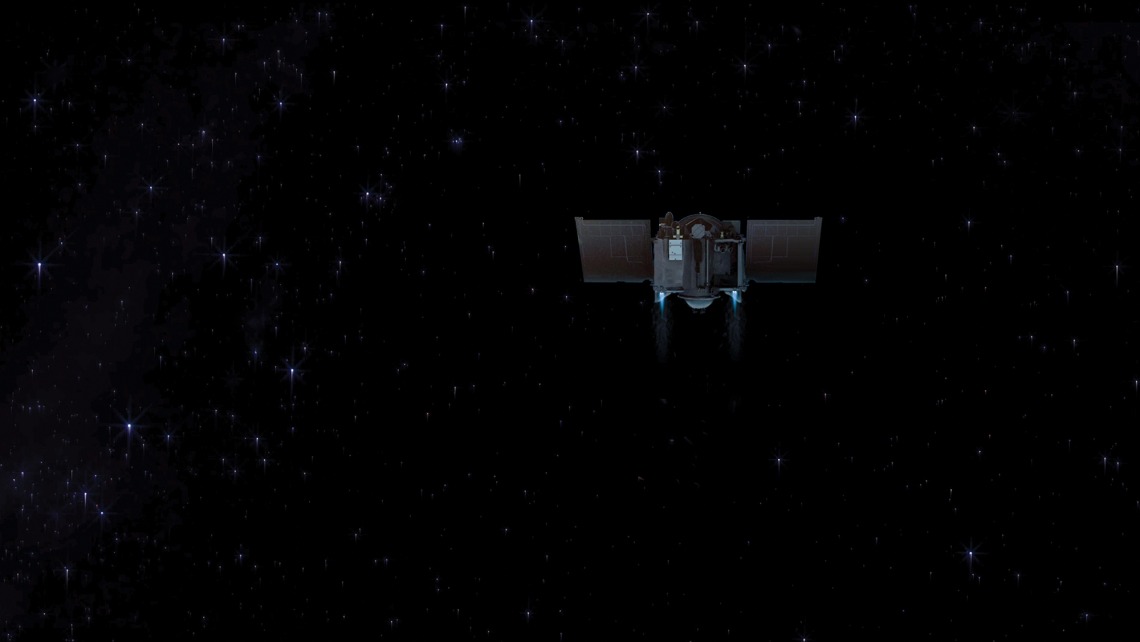OSIRIS-REx Captures First Glimpse of Asteroid Bennu

Artist’s conception of NASA’s OSIRIS-REx spacecraft during a burn of its main engine / Heather Roper illustration
After an almost two-year journey through space, NASA’s asteroid sampling spacecraft, OSIRIS-REx, caught its first glimpse of asteroid Bennu on Aug. 17 and began the final approach toward its target.
The spacecraft’s PolyCam camera, one of three cameras on board, obtained the image from a distance of 1.4 million miles. All the cameras were developed at the University of Arizona, and together make up the OSIRIS-REx Camera Suite, OCAMS for short.
Led by the UA’s Lunar and Planetary Laboratory, OSIRIS-REx is NASA’s first mission to visit a near-Earth asteroid, survey the surface, collect a sample and deliver it safely back to Earth. The spacecraft has traveled approximately 1.1 billion miles since its Sept. 8, 2016, launch, and it is scheduled to arrive at Bennu on Dec. 3.
“Now that OSIRIS-REx is close enough to observe Bennu, the mission team will spend the next few months learning as much as possible about Bennu’s size, shape, surface features and surroundings before the spacecraft arrives at the asteroid,” says Dante Lauretta, OSIRIS-REx principal investigator and professor of planetary science at the UA. “After spending so long planning for this moment, I can’t wait to see what Bennu reveals to us.”
To boost itself onto Bennu’s orbital plane, OSIRIS-REx performed a slingshot maneuver, or gravity assist, around Earth in September 2017. The craft is now zipping along at almost 32,000 mph relative to Earth, while catching up with Bennu at a little over 1,200 mph relative to the asteroid.
As OSIRIS-REx approaches the asteroid, the spacecraft will use its science instruments to gather information about Bennu and prepare for arrival. In addition to the OCAMS camera suite, the spacecraft’s science payload includes a thermal spectrometer, a visible and infrared spectrometer, a laser altimeter and an X-ray spectrometer.
During the mission’s approach phase, OSIRIS-REx will:
Regularly observe the area around the asteroid to search for dust plumes and natural satellites and to study Bennu’s light and spectral properties.
Execute a series of four asteroid approach maneuvers beginning on Oct. 1, slowing the spacecraft to match Bennu’s speed and trajectory.
Jettison the protective cover of the spacecraft’s sampling arm in mid-October and subsequently extend and image the arm for the first time in flight.
Use OCAMS in late October to reveal the asteroid’s overall shape, and begin detecting Bennu’s surface features in mid-November.
After arrival at Bennu, the spacecraft will spend the first month performing flybys of Bennu’s north pole, equator and south pole, at distances between 11.8 and 4.4 miles from the asteroid. These maneuvers will allow for the first direct measurement of Bennu’s mass, as well as close-up observations of the surface. These trajectories will also provide the mission’s navigation team with experience navigating near the asteroid.
The spacecraft will extensively survey the asteroid before the mission team identifies two possible sample sites. Sample collection is scheduled for early July 2020, and the spacecraft will head back toward Earth before ejecting the Sample Return Capsule for landing in the Utah desert in September 2023.
NASA’s Goddard Space Flight Center provides overall mission management, systems engineering, and safety and mission assurance for OSIRIS-REx. Lauretta is the principal investigator, and the UA also leads the science team and the mission’s science observation planning and data processing.
Lockheed Martin Space Systems in Denver built the spacecraft and is providing flight operations. Goddard and KinetX Aerospace are responsible for navigating the OSIRIS-REx spacecraft.
OSIRIS-REx is the third mission in NASA’s New Frontiers Program. NASA’s Marshall Space Flight Center in Huntsville, Alabama, manages the agency’s New Frontiers Program for its Science Mission Directorate in Washington.
